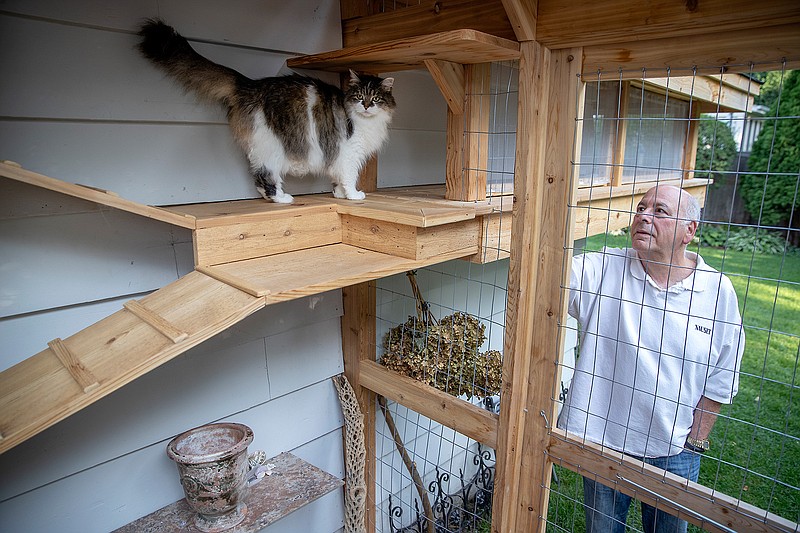In their new outdoor living room, Coco and Rosie have lounging areas, exercise equipment, fragrant plants, tasteful lighting accents and a water fountain. The three-season sanctuary is connected to the main house with a stylish elevated breezeway.
Coco and Rosie think they're worth it.
After all, they're cats.
The outside hangout for the two middle-aged Animal Humane Society adoptees was created by Suzy Kronfeld and her husband, David Baum.
They used to let their cats roam outside, but the Edina couple became increasingly worried about them being injured by cars or coyotes - or that they would harm other wildlife. When Coco insisted on being let out, the couple would follow her to make sure she didn't get into trouble.
"I wanted the cats to be safe. I wanted the birds to be safe. I wanted Coco to enjoy nature," Kronfeld said. "She really loves to be outdoors."
Then Kronfeld read about cat patios, better known as catios.
In recent years, do-it-yourself cat owners, pet companies and cat-friendly contractors have begun creating screened enclosures - which range in price from less than $50 to $30,000 - that keep cats safe while letting them enjoy fresh air, sunshine and the sights, sounds and smells of nature.
Kate Benjamin, founder of the Hauspanther.com website and co-author of "Catification," a book about cat-centric interior design, said catios started to become a thing about 10 years ago. They've become so much a part of the cat culture that some cities (including Portland, Ore., Seattle and Austin, Texas) have catio tours. They've even become a niche in the home improvement industry, with contractors specializing in costly catios and designers turning out catio kits.
A catio can be as simple as a wire-mesh box attached outside a window. But it also can be a screened-in apartment balcony, or a custom-designed, room-sized deck fenced in and outfitted for felines.
That's what Kronfeld and Baum opted to build for their cats this summer. The wood-framed screened enclosure in their backyard measures about 10 by 13 feet and about 9 feet high.
Inside are elevated lounging and observation platforms, hiding places, cat-friendly plants, a large red pine branch for climbing and a sisal-wrapped pole for scratching. There's some human furniture there, too, as well as a potting bench.
The cats get to their catio by going through a pet door installed in a window of the house and then walking along an enclosed, elevated catwalk - a sort of kitty-sized skyway - that extends about 30 feet, rising over a trellis, wrapping around the garage and connecting to the catio. Access hatches are built into the walkway in case a human needs to reach in to help out a cat.
The couple hired general contractor John Denn for the job this summer - even though he admitted he'd never heard of a catio before. He said the project was similar to building a screened-in porch, except with some feline-oriented features.
"My wife helped with some of the design," he said. He estimated the project took more than 100 hours of labor. "It's very custom."
(Kronfeld did not want to reveal how much the project ultimately cost.)
"The catio is more involved than knocking out a bird house in your garage," said David Murphy, an Austin, Texas, woodworker who has built more than 150 catios as The Cat Carpenter, a business he started about five years ago after he got laid off from his previous job as an accountant. "People who build things usually aren't cat people. And people who like cats typically don't know which end of the hammer to hold."

